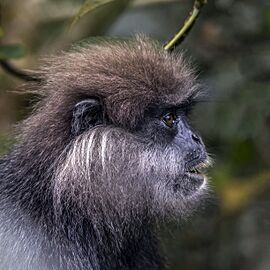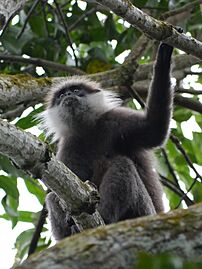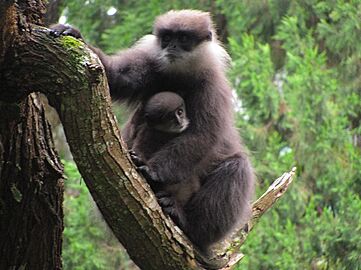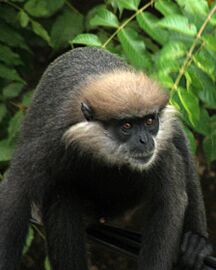Purple-faced langur facts for kids
Quick facts for kids Purple-faced langur |
|
|---|---|
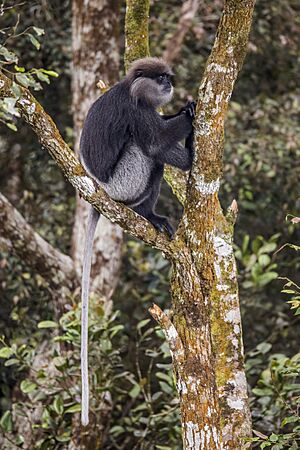 |
|
| Semnopithecus vetulus vetulus | |
| Conservation status | |
| Scientific classification | |
| Genus: |
Semnopithecus
|
| Species: |
vetulus
|
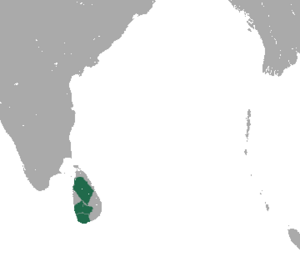 |
|
| Purple-faced langur range | |
| Synonyms | |
|
Trachypithecus vetulus |
|
The purple-faced langur (Semnopithecus vetulus) is a type of Old World monkey. It is also called the purple-faced leaf monkey. This monkey lives only in Sri Lanka. It has a long tail and spends most of its life in trees.
These langurs are mostly brown with a dark face. Their lower face is a bit lighter. They are also known for being very shy. Long ago, many purple-faced langurs lived in cities like Colombo. They also lived in "wet zone" villages. These areas have high heat and humidity all year. Heavy rains happen during the monsoon seasons. However, cities have grown very fast. This has caused the number of these monkeys to drop a lot.
Scientists used to group this monkey with Trachypithecus langurs. But new DNA studies show it is closer to the gray langurs. So, it was moved to the Semnopithecus group. In Sinhala, people call it ශ්රී ලංකා කළු වඳුරා (Sri Lanka black monkey). This means "Sri Lanka black monkey."
Contents
What Does a Purple-faced Langur Look Like?
Male purple-faced langurs are usually bigger than females. Males are about 50 to 67.1 cm (19.7 to 26.4 in) long from head to body. Their tails can be 67 to 85.1 cm (26.4 to 33.5 in) long. Females are 44.7 to 60 cm (17.6 to 23.6 in) long. Their tails are 58.9 to 82 cm (23.2 to 32.3 in) long.
Their fur can be blackish or grayish. They often have short, whitish or gray fur on their legs. Their faces are purplish-black with white fur on the sides. Part of their back has whitish fur. Their tails have a mix of black and white colors. Their feet and hands are also purplish-black.
The size of these monkeys changes depending on their type. Most adults weigh between 3.1 and 11.4 kg (6.8 and 25.1 lb). The average weight is about 7.08 kg (15.6 lb). The smallest type, S. v. nestor, usually weighs between 3.8 and 6 kg (8.4 and 13.2 lb). Some very large langurs can weigh up to 18 kg (40 lb).
Among Sri Lanka's primates, the purple-faced langur is a bit smaller than the tufted gray langur. But the main male purple-faced langurs can be larger. One type, called the "bear monkey" (S. v. monitcola), has darker fur. It also usually has a thick mustache. The hair on its head points backward. It does not have a crest like the tufted gray langur. The hair on its head is not longer than on its temples or neck. Purple-faced langurs have a pure white or whitish-gray rump.
Different Types of Purple-faced Langurs
The book "Mammals of Sri Lanka" lists four types of purple-faced langurs:
- Southern lowland wetzone purple-faced langur (Semnopithecus vetulus vetulus): Its color varies a lot. It has a black upper body and a light brown cap. It has a clear silvery patch on its rump that goes down its legs. It also has strong white whiskers. Its tail is white. Some of these langurs are all white or partly white due to leucism.
- Western purple-faced langur or north lowland wetzone purple-faced langur (Semnopithecus vetulus nestor): This is the smallest type. It has a dark grayish-brown upper body. Its rump patch is light grayish-brown. Its legs are darker grayish-brown, and it has a white cap. This type is one of the 25 most endangered primates in the world.
- Dryzone purple-faced langur (Semnopithecus vetulus philbricki): This is the largest type. It has a grayish-brown body and a dark cap. Its grayish rump patch is not very clear. It has noticeable white cheeks with tufts of fur. Its tail is very long and thin.
- Montane purple-faced langur or Bear Monkey (Semnopithecus vetulus monticola): It has a dark gray-brown coat. Its grayish rump patch is large but not very clear. It has strong white cheek tufts and a light brownish-gray cap. Its fur is long and shaggy because it lives in cold places.
All four of these types have different skull shapes, fur, and body sizes. Most groups of langurs have only one adult male.
There might be a fifth type called Semnopithecus vetulus harti. It is found in the Jaffna peninsula and north of Vavuniya. This type has unique yellowish-golden hair on its head. Its fur also has a golden shine. Other than these differences, it looks like Semnopithecus vetulus philbricki.
Where Do Purple-faced Langurs Live?
The purple-faced langur lives in thick forests in Sri Lanka's mountains. It also lives in the southwestern part of the country, called the "wet zone." Sri Lanka used to have many forests. But the amount of forest has dropped a lot. In 1980, 80% of Sri Lanka was forest. By 2001, it was about 25%. Now, it is less than 3%.
The areas where langurs live are now often crowded with people. Because of trees being cut down, the langurs' homes are now open to direct sunlight. Purple-faced langurs are usually found in small groups. These groups are far apart from each other. Ninety percent of the langurs' homes are now in areas where humans live. Their numbers are very low in these places.
Many things threaten these monkeys. These include farms, grazing animals, new roads, and soil loss. People also cut down too many trees. Sometimes, langurs are poisoned to stop them from eating crops. They are also hunted for medicine and food.
Even with these threats, you can still see them in some places. These include Sinharaja, Kitulgala, Kandalama, Mihintale, and Horton Plains National Park. You might also find them in the rainforest near the city of Galle.
How Do Purple-faced Langurs Live?
What Do Purple-faced Langurs Eat?
Purple-faced langurs mostly eat leaves. But they also eat fruits, flowers, and seeds. They usually stay away from human homes. However, if they live near people, fruits like jak (Artocarpus heterophyllus), rambutan (Nephelium lappaceum), banana (Musa balbisiana), and mango (Mangifera indica) can make up half of their diet. In the wild, they eat fruits from trees like Dimocarpus longan and Drypetes sepiaria.
Their bodies are made to get most of their food and energy from the complex sugars in leaves. They have special stomach bacteria that help them do this. If they eat too many cultivated fruits, they might not get enough nutrients. This can be worse when certain fruits are not in season.
Semnopithecus vetulus eats fewer different types of food than S. priam. They eat more leaves. Some plants they eat include Holoptelea integrifolia, Hydnocarpus venenata, Macaranga peltata, Manilkara hexandra, Mikania scandens, Mischodon zeylanica, Pterospermum suberifolium, Tetrameles nudiflora, Vitex altissima, and Wrightia angustifolia. When purple-faced langurs are in mixed groups with tufted gray langurs, the tufted gray langurs often take over.
How Do Purple-faced Langurs Communicate?
Purple-faced langurs often use loud calls to tell each other apart. Their calls have three parts: harsh barks, whoops, and other sounds. You can tell individual monkeys apart by how many sounds they make in a call. They call more often in the morning. This is usually because of nearby groups or fights over territory. They call more on sunny days than on cloudy ones. They call the least in the evening. Daytime calls help them protect their home areas.
The loud barking call, especially from langurs in the mountains, can sound like a leopard's roar. The calls of different types of purple-faced langurs are different. Human activities can also affect when they call. They use their voices to warn about predators, attract mates, protect their territory, and find other group members. It is very important to study their calls for conservation. This is because they are hard to see directly. Adult males are the loudest in the group. When they make defensive whooping calls, they also make strong visual displays and movements.
Their calls also help scientists figure out what type of langur they are. Based on their alarm calls, their main predators are likely leopards. Sometimes, Indian pythons and mugger crocodiles might also be a threat. For young or sick langurs, large birds of prey like black eagles and spot-bellied eagle-owls can be dangerous. Monitor lizards might also eat purple-faced langurs. This could be by eating dead ones or catching young or sick ones.
How Can We Help Purple-faced Langurs?
To help these langurs, we need to improve how we manage protected areas. We also need to find and protect new areas and safe paths for them. Efforts to help their numbers grow could help them survive. It would be good to reduce problems between humans and langurs.
People could build rope bridges for langurs to move safely between areas. This might stop them from crossing power lines and roads. Planting native trees where pine trees used to be could also create more of their favorite habitat. Teaching local people about conservation is also important. This means showing kindness to these animals. It also means explaining how important these mammals are for all the different living things in the ecosystem.



